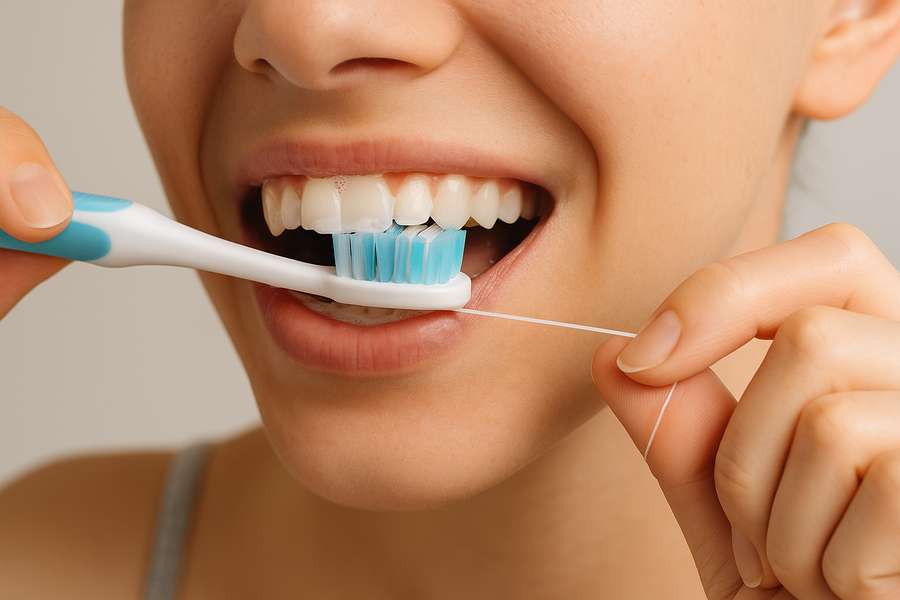
Brushing and Flossing: The Essential Foundation of Dental Health
Maintaining oral hygiene isn’t just about brushing once a day. For Indians dealing with sweet-rich diets, sticky snacks, and spicy foods, an effective combination of brushing and flossing is essential to prevent tooth decay, gum problems, and bad breath. In this complete guide, you’ll learn how Indian dentists recommend you brush and floss daily — the right way.
Table of Contents
Why Brushing and Flossing Matter
Many Indians brush their teeth but skip flossing — leading to plaque buildup, inter-dental decay, and inflamed gums. Indian dentists stress the combined importance of brushing and flossing to clean both visible and hidden areas. Regular cleaning not only improves your breath but also reduces your risk of cavities, especially between molars where toothbrushes can’t reach.
Proper Brushing Techniques for Indian Oral Health
Indian dentists recommend the Modified Bass technique for best results. Here’s how to brush effectively:
- Use a soft-bristled toothbrush
- Hold it at a 45-degree angle to your gumline
- Use small, circular motions — not back-and-forth sawing strokes
- Cover all surfaces — outer, inner, and chewing areas
- Brush for a full 2 minutes
Ensure you brush before bedtime — especially if you’ve had sweets or tea during the day. Want a deeper dive into proper methods? Check out our detailed guide on brushing techniques.
Flossing Techniques for the Indian Lifestyle
Due to the fibrous nature of Indian food (like sabzi and rotis), food particles often lodge between teeth. Flossing is key to dislodging them.
Here’s how Indian dentists recommend you floss:
- Take about 18 inches of floss, wind most of it on your middle fingers
- Gently slide the floss between teeth using a zig-zag motion
- Curve the floss into a C-shape around the tooth and move it up and down
- Use fresh sections of floss for each tooth
If you find string floss difficult, try using pre-threaded floss picks or interdental brushes. These are especially helpful for older adults or teenagers with braces.
Recommended Brushing and Flossing Products in India
- Toothbrush: Colgate Slim Soft or Oral-B CrossAction (Soft)
- Fluoride toothpaste: Dabur Red Paste (natural) or Sensodyne (sensitive teeth)
- Floss: Oral-B Essential Floss or Colgate Total Dental Floss
- Tongue cleaner: Stainless steel or plastic tongue scraper
- Mouthwash (optional): Alcohol-free Listerine or Ayurvedic options
These items are widely available in Indian pharmacies or supermarkets. According to Indian Dental Association, fluoride-based products and regular flossing show a significant reduction in plaque scores.
When and How Often Should You Brush and Floss?
Brushing: Twice a day – once after waking up and again before going to sleep.
Flossing: At least once daily, ideally before bedtime to remove the day’s debris.
Don’t forget to rinse your mouth after meals, especially if you consume sticky sweets like gulab jamun or jaggery-based snacks. Good rinsing complements brushing and flossing efforts.
Common Brushing and Flossing Mistakes to Avoid
- Brushing too aggressively
- Using a hard-bristled brush
- Skipping flossing because “food didn’t get stuck”
- Not replacing your brush every 3 months
- Flossing incorrectly (snapping it into the gums)
Each of these mistakes can harm your enamel, irritate your gums, or make your efforts ineffective.
FAQs on Brushing and Flossing
1. What’s better — brushing or flossing?
Both are essential. Brushing cleans the outer tooth surfaces while flossing removes plaque and food between teeth. They work best together.
2. Should I floss before or after brushing?
Flossing before brushing is more effective. It loosens debris and allows toothpaste fluoride to reach better between teeth.
3. Is flossing really necessary if I use mouthwash?
Yes. Mouthwash may reduce bacteria but won’t physically remove food particles. Flossing does the actual cleaning between teeth.
4. Can children floss too?
Yes. Kids above 6 can floss with supervision. Use child-safe flossers or sticks. Build the habit early to avoid cavities later.
5. What if my gums bleed when I floss?
Slight bleeding is normal at first but should stop in a few days. If it continues, it could signal gum disease. See a dentist.
6. How long should I floss each day?
Flossing should take about 2–3 minutes. Don’t rush — clean every gap carefully, especially back molars.
7. Which is better: floss string or floss picks?
Both work well. Floss string allows more control, while picks are convenient. Use whatever suits your comfort and consistency.
